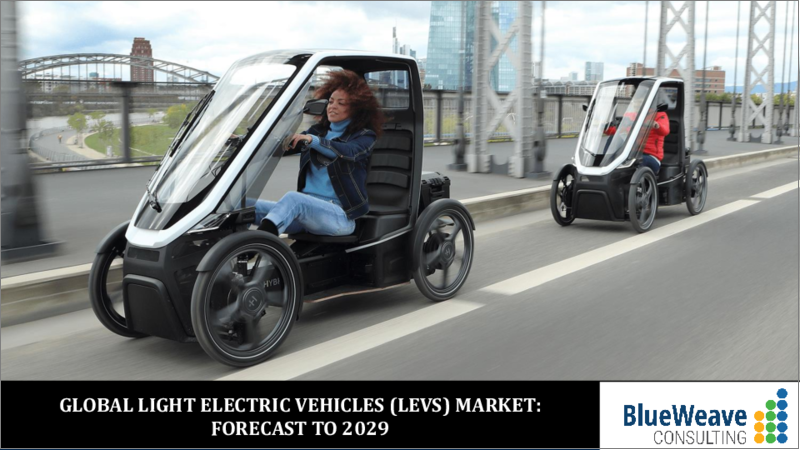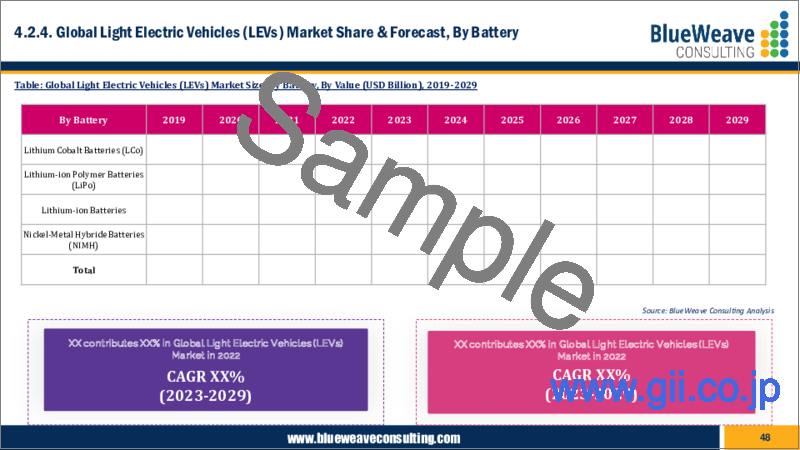|
|
市場調査レポート
商品コード
1227634
小型電気自動車の世界市場 - 世界の規模、シェア、動向分析、機会、予測レポート:車両カテゴリー別、用途別、出力別、コンポーネント別、車両タイプ別、地域別(2019年~2029年)Light Electric Vehicles Market - Global Size, Share, Trend Analysis, Opportunity and Forecast Report, 2019-2029, Segmented By Vehicle Category ; By Application ; By Power Output ; By Component ; By Vehicle Type ; By Region |
||||||
| 小型電気自動車の世界市場 - 世界の規模、シェア、動向分析、機会、予測レポート:車両カテゴリー別、用途別、出力別、コンポーネント別、車両タイプ別、地域別(2019年~2029年) |
|
出版日: 2023年02月27日
発行: Blueweave Consulting
ページ情報: 英文 400 Pages
納期: 2~3営業日
|
- 全表示
- 概要
- 目次
世界の小型電気自動車の市場規模は、2022年は775億2,000万米ドルと推定され、2023年から2029年の予測期間中に9.1%の著しいCAGRで成長し、2029年には1,417億9,000万米ドルに達すると予されています。市場の成長を後押しする主な要因には、レクリエーションや商用目的での需要の増加、政府のインセンティブや補助金、再生可能エネルギー産業の進歩などが挙げられます。
当レポートでは、世界の小型電気自動車市場を調査しており、市場の概要、市場規模や予測、動向、促進要因・抑制要因、車両カテゴリー別・用途別・出力別・コンポーネント別・車両タイプ別・地域別の分析、および企業プロファイルなどの包括的な情報を提供しています。
目次
第1章 調査の枠組み
第2章 エグゼクティブサマリー
第3章 世界の小型電気自動車市場の洞察
- 業界バリューチェーン分析
- DROC分析
- 促進要因
- 政府のイニシアチブと補助金
- バッテリー技術の進歩
- 抑制要因
- 限られた範囲と高い初期所有コスト
- 機会
- バッテリー交換の使用
- 課題
- 互換性の欠如
- 技術の進歩/最近の開発
- 規制の枠組み
- ポーターのファイブフォース分析
- 供給企業の交渉力
- 買い手の交渉力
- 新規参入業者の脅威
- 代替品の脅威
- 競争の激しさ
第4章 世界の小型電気自動車市場概要
- 市場規模と予測(2019年~2029年)
- 金額別
- 市場シェアと予測
- 車両カテゴリー別
- 二輪車
- 三輪車
- 四輪車
- 用途別
- パーソナルモビリティ
- 共有モビリティ
- レクリエーション・スポーツ
- 商業
- 出力別
- 6kW未満
- 6~9kW
- 9~15kW
- コンポーネント別
- バッテリーパック
- 電気モーター(推進モーター)
- モーターコントローラー
- インバーター
- パワーコントローラー
- eブレーキブースター
- パワーエレクトロニクス
- 車両タイプ別
- e-ATV/UTV
- 電動自転車
- eスクーター
- 電動バイク
- その他
- 地域別
- 北米
- 欧州
- アジア太平洋
- ラテンアメリカ
- 中東・アフリカ
- 車両カテゴリー別
第5章 北米の小型電気自動車市場
- 市場規模と予測(2019年~2029年)
- 金額別
- 市場シェアと予測
- 車両カテゴリー別
- 用途別
- 出力別
- コンポーネント別
- 車両タイプ別
- 国別
- 米国
- カナダ
第6章 欧州の小型電気自動車市場
- 市場規模と予測(2019年~2029年)
- 金額別
- 市場シェアと予測
- 車両カテゴリー別
- 用途別
- 出力別
- コンポーネント別
- 車両タイプ別
- 国別
- ドイツ
- 英国
- イタリア
- フランス
- スペイン
- オランダ
- その他の欧州
第7章 アジア太平洋の小型電気自動車市場
- 市場規模と予測(2019年~2029年)
- 金額別
- 市場シェアと予測
- 車両カテゴリー別
- 用途別
- 出力別
- コンポーネント別
- 車両タイプ別
- 国別
- 中国
- インド
- 日本
- 韓国
- オーストラリア・ニュージーランド
- インドネシア
- マレーシア
- シンガポール
- フィリピン
- ベトナム
- その他のアジア太平洋
第8章 ラテンアメリカの小型電気自動車市場
- 市場規模と予測(2019年~2029年)
- 金額別
- 市場シェアと予測
- 車両カテゴリー別
- 用途別
- 出力別
- コンポーネント別
- 車両タイプ別
- 国別
- ブラジル
- メキシコ
- アルゼンチン
- ペルー
- その他のラテンアメリカ
第9章 中東・アフリカの小型電気自動車市場
- 市場規模と予測(2019年~2029年)
- 金額別
- 市場シェアと予測
- 車両カテゴリー別
- 用途別
- 出力別
- コンポーネント別
- 車両タイプ別
- 国別
- サウジアラビア
- アラブ首長国連邦
- カタール
- クウェート
- 南アフリカ
- ナイジェリア
- アルジェリア
- その他の中東・アフリカ
第10章 競合情勢
- 主な企業とその製品のリスト
- 世界の小型電気自動車企業の市場シェア分析、2022年
- 運用パラメータ別の競合ベンチマーキング
- 主要な戦略的展開(合併、買収、パートナーシップなど)
第11章 世界の小型電気自動車市場に対するCOVID-19の影響
第12章 企業プロファイル(会社概要、財務マトリックス、競合情勢、主要な人材、主要な競合、連絡先、戦略的展望、SWOT分析)
- Accelerated Systems Inc.
- Addax Motors
- Aisin Corporation
- Alke
- American Landmaster
- Ari Motors
- Auro Robotics
- Auto Rennen India
- Balkancar Record
- BMW AG
- Borgwarner Inc.
- Byd Auto Co. Ltd.
- Cfmoto
- Club Car Inc.
- Columbia Vehicle Group Inc.
- Continental AG
- Crossfire Motorcycles
- Crystalyte Motors
- その他の有力企業
第13章 主要な戦略的推奨事項
第14章 調査手法
Global Light Electric Vehicles Market Size Expands to Reach USD 142 Billion by 2029.
Global light electric vehicles market is flourishing because of governments' supportive initiatives and subsidies, rapid urbanization, and growing advancements in battery technologies.
BlueWeave Consulting, a leading strategic consulting and market research firm, in its recent study, estimated global light electric vehicles market size at USD 77.52 billion in 2022. During the forecast period between 2023 and 2029, BlueWeave expects global light electric vehicles market size to grow at a significant CAGR of 9.1% reaching a value of USD 141.79 billion by 2029. Major growth factors of global light electric vehicles market include increasing demand from recreational and commercial purposes, government incentives and subsidies, and advancements in the renewable energy industry. The advancements of battery and electric motor technology, as well as government efforts to limit pollution in metropolitan areas, have raised demand for LEVs throughout the years. The rapid deployment of charging stations around the world has raised demand for LEVs, such as e-bikes, e-scooters, e-motorcycles, and neighborhood electric vehicles (golf carts/others). Technical advancements in EV batteries and other EV technologies have enabled high-power engines to be used in electric ATVs and UTVs for off-roading (comparable to their ICE counterparts). In the coming years, demand for electric ATVs and UTVs will shift. However, limited range and high initial ownership cost is anticipated to restrain the overall market growth.
Global Light Electric Vehicles Market - Overview:
An electric vehicle is a vehicle powered by one or more electric motors. It can be powered by a collector system or by a battery on its own (sometimes charged with solar panels, or by converting fuel to electricity using fuel cells or a generator). Surface and underwater watercraft, road and rail vehicles, electric aero planes, and electric spaceships are all examples of EVs. EVs first debuted a long time ago, when electricity was one of the favored methods of motor vehicle propulsion, providing a level of comfort and convenience of operation that gasoline automobiles of the time couldn't match. Furthermore, internal combustion engines dominated automotive and truck propulsion, but electric power remained common in trains and smaller vehicles of all sorts. Electric vehicles are either powered by a collector system, which collects electricity from charging station deployments, or by self-charging equipment such as turbochargers, regenerative braking systems, and other similar devices.
Impact of COVID-19 on Global Light Electric Vehicles Market
COVID-19 had a detrimental impact on the market for light electric vehicles. One of the first casualties of the economic slump has been declining global crude oil prices. Low gasoline prices harm the economic viability of EV adoption in comparison to combustion vehicles, particularly in countries with limited EV fiscal incentives. If global oil prices remain at current levels, the significantly higher total cost of ownership for EVs may stymie the transition. Disruptions in the supply chain pose an additional serious danger to EV adoption. China is the most important supplier of EV manufacturing ecosystem components. In such a case, the transition path will differ from country to country, based on each country's ability to build an indigenous supply chain within a given timescale. However, post COVID-19 global light vehicle market has experienced exponential growth as a result of government financial and promotional backing, as well as the emergence of an eco-friendly environment.
Global Light Electric Vehicles Market - By Power Output:
Based on power output, global light electric vehicles market is divided into Less than 6 kW, ¬6-9 kW, and 9-15 kW. In the light electric car market in 2022, the segment with less than 6 kW had the highest revenue share. The rising demand for LEVs with compact seating capacity for personal commuting and shared mobility applications is expected to enhance sales of electric scooters and electric cycles with low power (less than 6 kW). Because of the high demand, Chinese producers send these low-power LEVs to North America and Europe at significantly lower prices.
Competitive Landscape:
Major players operating in global light electric vehicles market include: Accelerated Systems Inc., Addax Motors, Aisin Corporation, Alke, American Landmaster, Ari Motors, Auro Robotics, Auto Rennen India, Balkancar Record, BMW Ag, Borgwarner Inc., Byd Auto Co. Ltd., Cfmoto, Club Car Inc., Columbia Vehicle Group Inc., Continental Ag, Crossfire Motorcycles, and Crystalyte Motors. To further enhance their market share, these companies employ various strategies, including mergers and acquisitions, partnerships, joint ventures, license agreements, and new product launches.
The in-depth analysis of the report provides information about growth potential, upcoming trends, and statistics of Global Light Electric Vehicles Market. It also highlights the factors driving forecasts of total market size. The report promises to provide recent technology trends in Global Light Electric Vehicles Market and industry insights to help decision-makers make sound strategic decisions. Furthermore, the report also analyzes the growth drivers, challenges, and competitive dynamics of the market.
Table of Contents
1. Research Framework
- 1.1. Research Objective
- 1.2. Product Overview
- 1.3. Market Segmentation
2. Executive Summary
3. Global Light Electric Vehicles Market Insights
- 3.1. Industry Value Chain Analysis
- 3.1.1. DROC Analysis
- 3.1.2. Growth Drivers
- 3.1.2.1. Government Initiatives and Subsidies
- 3.1.2.2. Advancements in Battery Technologies
- 3.1.3. Restraints
- 3.1.3.1. Limited Range and High Initial Ownership Cost
- 3.1.4. Opportunities
- 3.1.4.1. Use of Battery Swapping
- 3.1.5. Challenges
- 3.1.5.1. Lack of Compatibility
- 3.2. Technology Advancements/Recent Developments
- 3.3. Regulatory Framework
- 3.4. Porter's Five Forces Analysis
- 3.4.1. Bargaining Power of Suppliers
- 3.4.2. Bargaining Power of Buyers
- 3.4.3. Threat of New Entrants
- 3.4.4. Threat of Substitutes
- 3.4.5. Intensity of Rivalry
4. Global Light Electric Vehicles Market Overview
- 4.1. Market Size & Forecast, 2019-2029
- 4.1.1. By Value (USD Billion)
- 4.2. Market Share & Forecast
- 4.2.1. By Vehicle Category
- 4.2.1.1. 2-wheelers
- 4.2.1.2. 3-wheelers
- 4.2.1.3. 4-wheelers
- 4.2.2. By Application
- 4.2.2.1. Personal Mobility
- 4.2.2.2. Shared Mobility
- 4.2.2.3. Recreation & Sports
- 4.2.2.4. Commercial
- 4.2.3. By Power Output
- 4.2.3.1. Less than 6 kW
- 4.2.3.2. 6-9 kW
- 4.2.3.3. 9-15 kW
- 4.2.4. By Component
- 4.2.4.1. battery pack
- 4.2.4.2. electric motor (Propulsion Motor)
- 4.2.4.3. motor controller
- 4.2.4.4. inverters
- 4.2.4.5. power controller
- 4.2.4.6. e-brake booster
- 4.2.4.7. power electronics
- 4.2.5. By Vehicle Type
- 4.2.5.1. e-ATV/UTV
- 4.2.5.2. e-bike
- 4.2.5.3. e-scooter
- 4.2.5.4. e-motorcycle
- 4.2.5.5. Others
- 4.2.6. By Region
- 4.2.6.1. North America
- 4.2.6.2. Europe
- 4.2.6.3. Asia Pacific (APAC)
- 4.2.6.4. Latin America (LATAM)
- 4.2.6.5. Middle East and Africa (MEA)
- 4.2.1. By Vehicle Category
5. North America Light Electric Vehicles Market
- 5.1. Market Size & Forecast, 2019-2029
- 5.1.1. By Value (USD Billion)
- 5.2. Market Share & Forecast
- 5.2.1. By Vehicle Category
- 5.2.2. By Application
- 5.2.3. By Power Output
- 5.2.4. By Component
- 5.2.5. By Vehicle Type
- 5.2.6. By Country
- 5.2.6.1. US
- 5.2.6.1.1. By Vehicle Category
- 5.2.6.1.2. By Application
- 5.2.6.1.3. By Power Output
- 5.2.6.1.4. By Component
- 5.2.6.1.5. By Vehicle Type
- 5.2.6.2. Canada
- 5.2.6.2.1. By Vehicle Category
- 5.2.6.2.2. By Application
- 5.2.6.2.3. By Power Output
- 5.2.6.2.4. By Component
- 5.2.6.2.5. By Vehicle Type
6. Europe Light Electric Vehicles Market
- 6.1. Market Size & Forecast, 2019-2029
- 6.1.1. By Value (USD Billion)
- 6.2. Market Share & Forecast
- 6.2.1. By Vehicle Category
- 6.2.2. By Application
- 6.2.3. By Power Output
- 6.2.4. By Component
- 6.2.5. By Vehicle Type
- 6.2.6. By Country
- 6.2.6.1. Germany
- 6.2.6.1.1. By Vehicle Category
- 6.2.6.1.2. By Application
- 6.2.6.1.3. By Power Output
- 6.2.6.1.4. By Component
- 6.2.6.1.5. By Vehicle Type
- 6.2.6.2. UK
- 6.2.6.2.1. By Vehicle Category
- 6.2.6.2.2. By Application
- 6.2.6.2.3. By Power Output
- 6.2.6.2.4. By Component
- 6.2.6.2.5. By Vehicle Type
- 6.2.6.3. Italy
- 6.2.6.3.1. By Vehicle Category
- 6.2.6.3.2. By Application
- 6.2.6.3.3. By Power Output
- 6.2.6.3.4. By Component
- 6.2.6.3.5. By Vehicle Type
- 6.2.6.4. France
- 6.2.6.4.1. By Vehicle Category
- 6.2.6.4.2. By Application
- 6.2.6.4.3. By Power Output
- 6.2.6.4.4. By Component
- 6.2.6.4.5. By Vehicle Type
- 6.2.6.5. Spain
- 6.2.6.5.1. By Vehicle Category
- 6.2.6.5.2. By Application
- 6.2.6.5.3. By Power Output
- 6.2.6.5.4. By Component
- 6.2.6.5.5. By Vehicle Type
- 6.2.6.6. The Netherlands
- 6.2.6.6.1. By Vehicle Category
- 6.2.6.6.2. By Application
- 6.2.6.6.3. By Power Output
- 6.2.6.6.4. By Component
- 6.2.6.6.5. By Vehicle Type
- 6.2.6.7. Rest of Europe
- 6.2.6.7.1. By Vehicle Category
- 6.2.6.7.2. By Application
- 6.2.6.7.3. By Power Output
- 6.2.6.7.4. By Component
- 6.2.6.7.5. By Vehicle Type
7. Asia-Pacific Light Electric Vehicles Market
- 7.1. Market Size & Forecast, 2019-2029
- 7.1.1. By Value (USD Billion)
- 7.2. Market Share & Forecast
- 7.2.1. By Vehicle Category
- 7.2.2. By Application
- 7.2.3. By Power Output
- 7.2.4. By Component
- 7.2.5. By Vehicle Type
- 7.2.6. By Country
- 7.2.6.1. China
- 7.2.6.1.1. By Vehicle Category
- 7.2.6.1.2. By Application
- 7.2.6.1.3. By Power Output
- 7.2.6.1.4. By Component
- 7.2.6.1.5. By Vehicle Type
- 7.2.6.2. India
- 7.2.6.2.1. By Vehicle Category
- 7.2.6.2.2. By Application
- 7.2.6.2.3. By Power Output
- 7.2.6.2.4. By Component
- 7.2.6.2.5. By Vehicle Type
- 7.2.6.3. Japan
- 7.2.6.3.1. By Vehicle Category
- 7.2.6.3.2. By Application
- 7.2.6.3.3. By Power Output
- 7.2.6.3.4. By Component
- 7.2.6.3.5. By Vehicle Type
- 7.2.6.4. South Korea
- 7.2.6.4.1. By Vehicle Category
- 7.2.6.4.2. By Application
- 7.2.6.4.3. By Power Output
- 7.2.6.4.4. By Component
- 7.2.6.4.5. By Vehicle Type
- 7.2.6.5. Australia & New Zealand
- 7.2.6.5.1. By Vehicle Category
- 7.2.6.5.2. By Application
- 7.2.6.5.3. By Power Output
- 7.2.6.5.4. By Component
- 7.2.6.5.5. By Vehicle Type
- 7.2.6.6. Indonesia
- 7.2.6.6.1. By Vehicle Category
- 7.2.6.6.2. By Application
- 7.2.6.6.3. By Power Output
- 7.2.6.6.4. By Component
- 7.2.6.6.5. By Vehicle Type
- 7.2.6.7. Malaysia
- 7.2.6.7.1. By Vehicle Category
- 7.2.6.7.2. By Application
- 7.2.6.7.3. By Power Output
- 7.2.6.7.4. By Component
- 7.2.6.7.5. By Vehicle Type
- 7.2.6.8. Singapore
- 7.2.6.8.1. By Vehicle Category
- 7.2.6.8.2. By Application
- 7.2.6.8.3. By Power Output
- 7.2.6.8.4. By Component
- 7.2.6.8.5. By Vehicle Type
- 7.2.6.9. Philippines
- 7.2.6.9.1. By Vehicle Category
- 7.2.6.9.2. By Application
- 7.2.6.9.3. By Power Output
- 7.2.6.9.4. By Component
- 7.2.6.9.5. By Vehicle Type
- 7.2.6.10. Vietnam
- 7.2.6.10.1. By Vehicle Category
- 7.2.6.10.2. By Application
- 7.2.6.10.3. By Power Output
- 7.2.6.10.4. By Component
- 7.2.6.10.5. By Vehicle Type
- 7.2.6.11. Rest of APAC
- 7.2.6.11.1. By Vehicle Category
- 7.2.6.11.2. By Application
- 7.2.6.11.3. By Power Output
- 7.2.6.11.4. By Component
- 7.2.6.11.5. By Vehicle Type
8. Latin America Light Electric Vehicles Market
- 8.1. Market Size & Forecast, 2019-2029
- 8.1.1. By Value (USD Billion)
- 8.2. Market Share & Forecast
- 8.2.1. By Vehicle Category
- 8.2.2. By Application
- 8.2.3. By Power Output
- 8.2.4. By Component
- 8.2.5. By Vehicle Type
- 8.2.6. By Country
- 8.2.6.1. Brazil
- 8.2.6.1.1. By Vehicle Category
- 8.2.6.1.2. By Application
- 8.2.6.1.3. By Power Output
- 8.2.6.1.4. By Component
- 8.2.6.1.5. By Vehicle Type
- 8.2.6.2. Mexico
- 8.2.6.2.1. By Vehicle Category
- 8.2.6.2.2. By Application
- 8.2.6.2.3. By Power Output
- 8.2.6.2.4. By Component
- 8.2.6.2.5. By Vehicle Type
- 8.2.6.3. Argentina
- 8.2.6.3.1. By Vehicle Category
- 8.2.6.3.2. By Application
- 8.2.6.3.3. By Power Output
- 8.2.6.3.4. By Component
- 8.2.6.3.5. By Vehicle Type
- 8.2.6.4. Peru
- 8.2.6.4.1. By Vehicle Category
- 8.2.6.4.2. By Application
- 8.2.6.4.3. By Power Output
- 8.2.6.4.4. By Component
- 8.2.6.4.5. By Vehicle Type
- 8.2.6.5. Rest of LATAM
- 8.2.6.5.1. By Vehicle Category
- 8.2.6.5.2. By Application
- 8.2.6.5.3. By Power Output
- 8.2.6.5.4. By Component
- 8.2.6.5.5. By Vehicle Type
9. Middle East & Africa Light Electric Vehicles Market
- 9.1. Market Size & Forecast, 2019-2029
- 9.1.1. By Value (USD Billion)
- 9.2. Market Share & Forecast
- 9.2.1. By Vehicle Category
- 9.2.2. By Application
- 9.2.3. By Power Output
- 9.2.4. By Component
- 9.2.5. By Vehicle Type
- 9.2.6. By Country
- 9.2.6.1. Saudi Arabia
- 9.2.6.1.1. By Vehicle Category
- 9.2.6.1.2. By Application
- 9.2.6.1.3. By Power Output
- 9.2.6.1.4. By Component
- 9.2.6.1.5. By Vehicle Type
- 9.2.6.2. UAE
- 9.2.6.2.1. By Vehicle Category
- 9.2.6.2.2. By Application
- 9.2.6.2.3. By Power Output
- 9.2.6.2.4. By Component
- 9.2.6.2.5. By Vehicle Type
- 9.2.6.3. Qatar
- 9.2.6.3.1. By Vehicle Category
- 9.2.6.3.2. By Application
- 9.2.6.3.3. By Power Output
- 9.2.6.3.4. By Component
- 9.2.6.3.5. By Vehicle Type
- 9.2.6.4. Kuwait
- 9.2.6.4.1. By Vehicle Category
- 9.2.6.4.2. By Application
- 9.2.6.4.3. By Power Output
- 9.2.6.4.4. By Component
- 9.2.6.4.5. By Vehicle Type
- 9.2.6.5. South Africa
- 9.2.6.5.1. By Vehicle Category
- 9.2.6.5.2. By Application
- 9.2.6.5.3. By Power Output
- 9.2.6.5.4. By Component
- 9.2.6.5.5. By Vehicle Type
- 9.2.6.6. Nigeria
- 9.2.6.6.1. By Vehicle Category
- 9.2.6.6.2. By Application
- 9.2.6.6.3. By Power Output
- 9.2.6.6.4. By Component
- 9.2.6.6.5. By Vehicle Type
- 9.2.6.7. Algeria
- 9.2.6.7.1. By Vehicle Category
- 9.2.6.7.2. By Application
- 9.2.6.7.3. By Power Output
- 9.2.6.7.4. By Component
- 9.2.6.7.5. By Vehicle Type
- 9.2.6.8. Rest of MEA
- 9.2.6.8.1. By Vehicle Category
- 9.2.6.8.2. By Application
- 9.2.6.8.3. By Power Output
- 9.2.6.8.4. By Component
- 9.2.6.8.5. By Vehicle Type
10. Competitive Landscape
- 10.1. List of Key Players and Their Offerings
- 10.2. Global Light Electric Vehicles Company Market Share Analysis, 2022
- 10.3. Competitive Benchmarking, By Operating Parameters
- 10.4. Key Strategic Developments (Mergers, Acquisitions, Partnerships, etc.)
11. Impact of Covid-19 on Global Light Electric Vehicles Market
12. Company Profile (Company Overview, Financial Matrix, Competitive Landscape, Key Personnel, Key Competitors, Contact Address, Strategic Outlook, SWOT Analysis)
- 12.1. Accelerated Systems Inc.
- 12.2. Addax Motors
- 12.3. Aisin Corporation
- 12.4. Alke
- 12.5. American Landmaster
- 12.6. Ari Motors
- 12.7. Auro Robotics
- 12.8. Auto Rennen India
- 12.9. Balkancar Record
- 12.10. BMW AG
- 12.11. Borgwarner Inc.
- 12.12. Byd Auto Co. Ltd.
- 12.13. Cfmoto
- 12.14. Club Car Inc.
- 12.15. Columbia Vehicle Group Inc.
- 12.16. Continental AG
- 12.17. Crossfire Motorcycles
- 12.18. Crystalyte Motors
- 12.19. Other Prominent Players
13. Key Strategic Recommendations
14. Research Methodology
- 14.1. Qualitative Research
- 14.1.1. Primary & Secondary Research
- 14.2. Quantitative Research
- 14.3. Market Breakdown & Data Triangulation
- 14.3.1. Secondary Research
- 14.3.2. Primary Research
- 14.4. Breakdown of Primary Research Respondents, By Region
- 14.5. Assumptions & Limitations




